Key Takeaways
- Refinancing offers lower interest rates but can sacrifice federal loan protections.
- Avoid refinancing if reliant on federal benefits or market rates are high.
- Good credit and stable finances are key for securing the best refinancing terms.
- Alternatives include debt repayment strategies, employer assistance, or federal loan consolidation.
Refinancing has become a popular option for several debt scenarios, including student loans. Yet, only a few know the benefits of refinancing and what they might lose in the worst-case scenario.
If you’re like most of our first-time clients, asking questions such as ‘How can I refinance student loans?’ or ‘Is refinancing the best option for me?’, you’ll find the answers right here.
What Is Refinancing?
In simple terms, refinancing involves replacing an existing student loan with a new one, generally with better terms.
The good thing about refinancing is that your new loan will often have more flexible terms, such as lower interest rates, reduced monthly payments, and reduced duration.
While the primary essence of refinancing is to improve financial circumstances, any wrong step in calculations can cause complications in the long run.
For instance, extending the term of a loan to lower payments may result in higher interest payments over time. As such, it’s not an option for just anyone with existing debt.
Who Shouldn’t Consider Refinancing
Avoid refinancing if you fall into any of these categories:
1. You Depend on the Benefits of Federal Loans
Federal student loans offer unique benefits that can make repayment more manageable, such as Income-Driven Repayment (IDR) Plans, Loan Forgiveness programs, deferments, and interest subsidies.
However, federal repayment plans can be complex, and interest rates are not always the lowest available. Refinancing to a private loan may provide a lower interest rate and simpler terms, but it permanently removes these federal protections.
For instance, you have access to income-driven repayment plans, forbearance, and loan forgiveness programs as a federal loan borrower. However, refinancing would require a private lender, which permanently eliminates all federal protections and benefits.
If you rely on these safety nets, giving them up might not be worth a potentially lower interest rate.
2. You Have a Poor Credit Score
There’s also the matter of credit scores when dealing with private lenders. Refinancing only makes sense when the rates are reduced; it can only be possible if you have a reasonable credit score.
Scores above 740 are generally considered excellent; you can get the lowest possible rate with this, depending on your lender. However, you can still get a fair interest rate with scores in the 670-739 range (good credit).
3. Current Market Rates are High
Like every market, the loan market is affected by demand and supply laws. As such, there are times when you can find low interest rates and other times when the rates can be higher.
Refinancing rates fluctuate based on economic and market conditions. During periods of high rates, refinancing may be less advantageous, as borrowers might lock in at a rate that’s higher than ideal.
However, a viable strategy is to refinance at a manageable rate and then re-refinance later if lower rates become available. This allows borrowers to capture savings over time without waiting for a specific season.
Refinancing Misconceptions
- Refinancing Always Saves Money: Not necessarily. While refinancing can lower your interest rate, it may extend your loan term, causing you to pay more interest over time.
- Refinancing Federal Student Loans Is Always Better: Refinancing a federal loan with a private lender removes any federal protection. Once done, it’s irreversible.
- Credit Score Impact: Some borrowers worry that refinancing multiple times will harm their credit score. While refinancing does involve a hard credit inquiry, the impact on your score is usually minor and temporary, as the new loan replaces the old one. Generally, credit scores bounce back quickly after refinancing.
- Refinancing Fees: With our preferred lenders, refinancing is absolutely free—no origination fees, prepayment penalties, or hidden charges. While some lenders may charge fees, using recommended lenders can ensure a completely fee-free refinancing process.
Pros and Cons of Refinancing Student Loans
| Pros | Cons |
| You can enjoy lower interest rates | You would lose all your federal privileges and protections |
| Consolidation of multiple loans makes managing monthly payments easier | A strong credit score or creditworthy cosigner is required to qualify for the best rates |
| You can choose different repayment terms that suit your financial situation | You can expect to pay some fees |
| Over time reduced interest rates can lead to considerable long-term savings | If you choose variable-rate loans, your interest rate can rise unexpectedly with market changes |
| You can pay off your private student loans faster without being charged a prepayment penalty | Private lenders may not offer forbearance or deferment options as generous as those from federal loans |
How To Refinance a Student Loan
If you want to refinance your student loans, it’s worth learning about the right steps to take.
Step One: Understand Your “Why”
The one mistake students make during refinancing is doing it for the wrong reasons. They may have heard it’s the easiest way out of debt or been captured by fancy adverts from private lenders.
You may want to consider refinancing if you:
- Have multiple loans and want to consolidate them into one loan
- Plan to switch from a variable interest rate to a fixed interest rate
- Plan to pay off your loans faster without getting slammed with prepayment penalties
- Intend to release a cosigner
- No longer rely on Federal loan benefits
However, if you think your situation is tricky and you have no idea about the best choice, then contacting an expert like Student Loan Professor would be a great idea.
Step Two: Check Your Financial Situation
One reason for refinancing is to improve one’s financial situation. Yet, having stable finances is vital before refinancing.
How do you know if your financial situation is ok to refinance?
First, you want to check your monthly payment ability. Are you comfortable with your current payments? Do you want lower monthly payments, or are you aiming to pay off your debt faster?
Your credit score is the next thing to assess. Basically, any score below 650 doesn’t tell a good story about your repayment strategy. Therefore, lenders are unlikely to be willing to bargain at a low rate.
Ensure you improve your scores, in this case, before refinancing. Also, try to work up a step-by-step action plan with a student loan expert. This would create a means for you to get out of debt faster.
Lenders often check one final thing before granting a good refinancing deal: the Debt-to-Income Ratio (DTI).
Lenders prefer borrowers with a low DTI (somewhere below 50%). Ideally, your monthly debt payments should not exceed half of your gross monthly income.
If you don’t know your DTI, calculating it is pretty easy using this formula.
DTI = (Total Monthly Debt ÷ Gross Monthly Income) X 100
Your total monthly debt would include every loan you pay up monthly, such as credit card payments, auto loans, personal loans, and any other monthly debt obligations.
For instance, if your monthly debt is $600 and your monthly income is $3,000, your DTI is 20%, reflecting good financial responsibility.
Step Three: Let’s Go Shopping
Once you’ve settled every step involving your finances and goals, proceed to find the best lender.
There are three things we often love to consider in this case:
- Interest Rates: Fixed rates offer stability, while variable rates can be lower initially but may rise over time. Depending on what you want, you can choose a lender. Some private lenders, however, offer both options.
- Loan Terms: Some lenders offer private loans with a 10-year maximum term. If you want longer-term loans, you can find others offering up to 20 years. Remember that the longer the loan duration, the more interest you pay.
- Fees: Some lenders charge origination fees or prepayment penalties. Also, avoid lenders that have hidden fees.
Step Four: Apply for Prequalification
Most lenders allow you to check your rates without impacting your credit score. This is known as a soft credit pull.
It will give you an idea of the rates you’ll qualify for without a formal application. Prequalification isn’t a guarantee, but it’s a useful step.
Step Five: Submit an Application
Once you’ve chosen the best lender, complete their formal application. This will require a hard credit pull, which may slightly impact your credit score.
For this process, you can expect to provide:
- Identification (passport or driver’s license)
- Proof of graduation from your school
- Residency information (if applicable)
- Loan details and balances
Step Six: Review Terms and Sign
If approved, you will receive the loan terms. We recommend reviewing these details carefully before accepting.
- APR: Ensure the APR is lower than your current loans.
- Repayment Schedule: Double-check that the new monthly payment and repayment term align with your financial goals.
- Fees and Other Conditions: Ensure there are no hidden fees or restrictive conditions.
Best Refinance Loan Rates for Students
We recommend only working with trusted lenders, and rates vary over time, so listing specific rate ranges here may not reflect current options.
For up-to-date rate comparisons, contact our team, and we’ll guide you to the lenders with the best current terms.
Best Alternatives to Student Loan Refinance
If refinancing isn’t suitable for every borrower, what other options can be explored to ease the debt burden? Well, there are quite a few, but we would highlight the three best alternatives here.
Debt Avalanche or Snowball Repayment
For those who want to focus on paying off their loans without refinancing, two popular strategies are the debt avalanche and snowball methods.
Debt avalanche involves paying off loans with the highest interest rates first while making minimum payments on the others. This method minimizes interest paid over time.
Debt Snowball, on the other hand, requires paying off your smallest loans first, then rolling those payments into larger debts. This way, you build motivation as you see smaller loans disappear.
Employer Student Loan Repayment Assistance
It’s not exactly an option available to everyone, but some employers offer student loan repayment assistance as part of their benefit packages.
Some employers offer student loan repayment assistance as a benefit, contributing up to $5,250 annually tax-free toward an employee’s student loan. Note that this tax-free incentive expires at the end of 2025, so taking advantage of it now may be beneficial.
Federal Loan Consolidation
While refinancing can help you consolidate loans, doing a direct consolidation could be a better option if you hold several federal loans.
This will not always lower your payment or interest rate; however, it simplifies repayment by consolidating your loans into a single monthly payment. You may also qualify for different repayment plans or extend your loan term to reduce monthly payments.
Generally, this option provides some of the benefits of refinancing while preserving your federal benefits like forbearance. Importantly, it doesn’t apply to private loans.
Get Help from Student Loan Experts
Refinancing can be a great choice, considering its benefits. However, what’s great for another might not work in your situation. That’s why it’s always best to consult experts before making such decisions.
At Student Loan Professor, we’ve helped many students like you in the past make decisions like this at a crossroads. Our process is simple but centered on your needs and financial situation. Contact us; let’s help you out!
Brandon Barfield is the President and Co-Founder of Student Loan Professor, and is nationally known as student loan expert for graduate health professions. Since 2011, Brandon has given hundreds of loan repayment presentations for schools, hospitals, and medical conferences across the country. With his diverse background in financial aid, financial planning and student loan advisory, Brandon has a broad understanding of the intricacies surrounding student loans, loan repayment strategies, and how they should be considered when graduates make other financial decisions.



